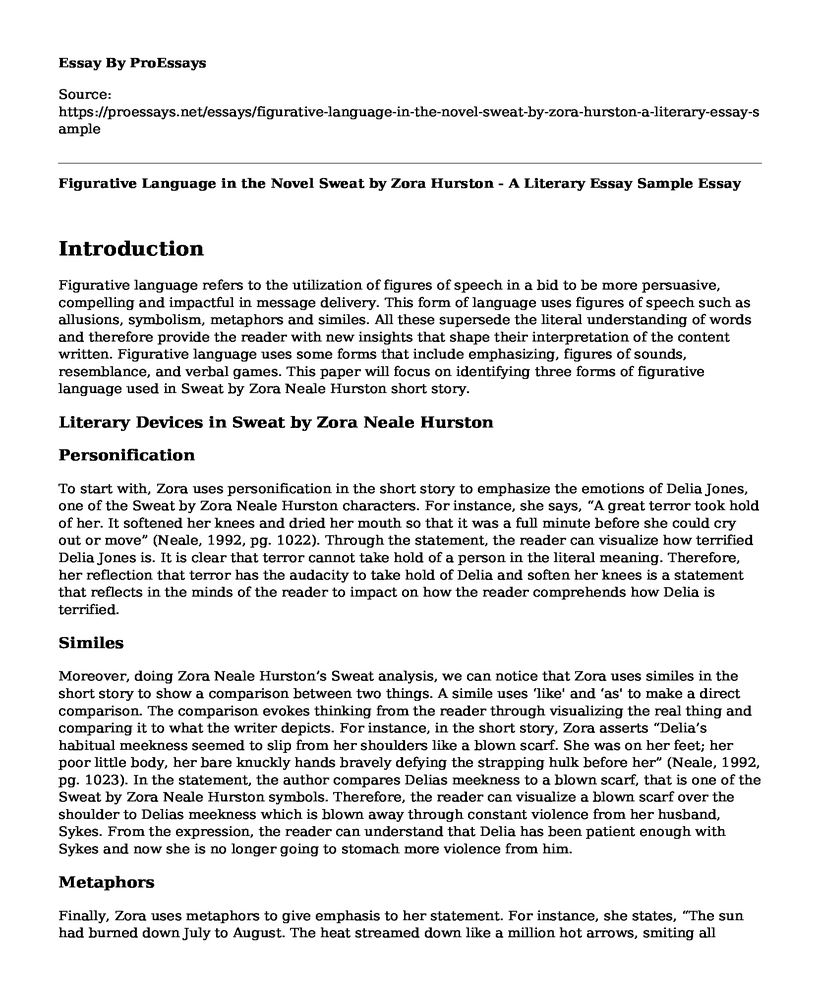Introduction
Figurative language refers to the utilization of figures of speech in a bid to be more persuasive, compelling and impactful in message delivery. This form of language uses figures of speech such as allusions, symbolism, metaphors and similes. All these supersede the literal understanding of words and therefore provide the reader with new insights that shape their interpretation of the content written. Figurative language uses some forms that include emphasizing, figures of sounds, resemblance, and verbal games. This paper will focus on identifying three forms of figurative language used in Sweat by Zora Neale Hurston short story.
Literary Devices in Sweat by Zora Neale Hurston
Personification
To start with, Zora uses personification in the short story to emphasize the emotions of Delia Jones, one of the Sweat by Zora Neale Hurston characters. For instance, she says, “A great terror took hold of her. It softened her knees and dried her mouth so that it was a full minute before she could cry out or move” (Neale, 1992, pg. 1022). Through the statement, the reader can visualize how terrified Delia Jones is. It is clear that terror cannot take hold of a person in the literal meaning. Therefore, her reflection that terror has the audacity to take hold of Delia and soften her knees is a statement that reflects in the minds of the reader to impact on how the reader comprehends how Delia is terrified.
Similes
Moreover, doing Zora Neale Hurston’s Sweat analysis, we can notice that Zora uses similes in the short story to show a comparison between two things. A simile uses ‘like' and ‘as' to make a direct comparison. The comparison evokes thinking from the reader through visualizing the real thing and comparing it to what the writer depicts. For instance, in the short story, Zora asserts “Delia’s habitual meekness seemed to slip from her shoulders like a blown scarf. She was on her feet; her poor little body, her bare knuckly hands bravely defying the strapping hulk before her” (Neale, 1992, pg. 1023). In the statement, the author compares Delias meekness to a blown scarf, that is one of the Sweat by Zora Neale Hurston symbols. Therefore, the reader can visualize a blown scarf over the shoulder to Delias meekness which is blown away through constant violence from her husband, Sykes. From the expression, the reader can understand that Delia has been patient enough with Sykes and now she is no longer going to stomach more violence from him.
Metaphors
Finally, Zora uses metaphors to give emphasis to her statement. For instance, she states, “The sun had burned down July to August. The heat streamed down like a million hot arrows, smiting all things living upon the earth. The grass withered, leaves browned, snakes went blind in shedding, and all men and dogs went mad (Neale, 1992, pg. 1026).” Through the statement, Zora sufficiently uses a metaphor and simile to emphasize the extremes of the sun and its effects on the earth, that makes Sweat by Zora Neale Hurston setting more impactful. The reader is enabled to understand the extreme of the scorching sun when it is compared to a ‘million hot arrows’ which strikes everything on earth and thereby lead to grass withering, leaves browning and snakes blind.
Conclusion
In conclusion, figures of speech are a recipe to effective, impactful and persuasive writing. Zora Neale Hurston is sufficient in the utilization of figures of speech to deliver her message to the readers. She uses the figurative language to directly appeal to the imaginations and senses of the reader and eventually attract their attention thereby encouraging correct and witty comprehension of the story. Finally, figurative language promotes lifelike features in the characters of the novel and our daily conversation.
Reference
Neale Hurston, Z. (1992). Sweat. Carol Oates, Joyce,( Ed.) Oxford: Oxford University Press. (1st ed., pp. 1022-1030).
Cite this page
Figurative Language in the Novel Sweat by Zora Hurston - A Literary Essay Sample. (2021, Apr 08). Retrieved from https://proessays.net/essays/figurative-language-in-the-novel-sweat-by-zora-hurston-a-literary-essay-sample
If you are the original author of this essay and no longer wish to have it published on the ProEssays website, please click below to request its removal:
- Literary Essay Example: Textual Analysis of Macbeth
- Poetry Analysis Essay on Kites by Raymond Souster
- Quotes Analysis: Silhouette by Langston Hughes
- The Quiet Torrential Sound Essay Example
- Literary Analysis Essay on "Sympathy" by Paul Laurence Dunbar
- Essay Sample on Comparing Two Distinct Authors: Maya Angelou & Harry Belafonte
- Elizabeth Barrett Browning: Poet of Love and Life - Essay Sample







